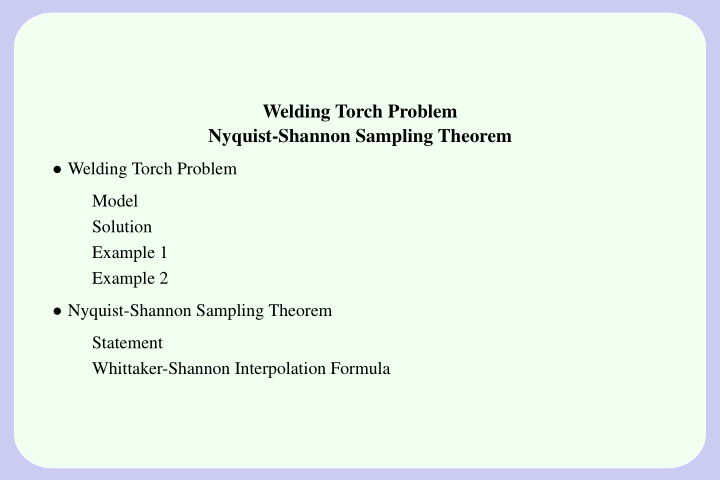



Welding Torch Problem Nyquist-Shannon Sampling Theorem • Welding Torch Problem Model Solution Example 1 Example 2 • Nyquist-Shannon Sampling Theorem Statement Whittaker-Shannon Interpolation Formula
Welding Torch Problem Consider a long welding rod insulated laterally by a sheath. At position x = 0 a small hole is drilled into the sheath, then a torch injects energy into the hole, which spreads into the rod. The hole is closed, and we call this time t = 0 . The problem is to determine the temperature u ( x, t ) at location x along the rod and time t > 0 . Modeling . = c 2 u xx , u t −∞ < x < ∞ , t > 0 u ( x, 0) = f ( x ) , −∞ < x < ∞ , f ( x ) = δ ( x ) (Dirac delta)
Solving the Welding Torch Problem We will use the Heat Kernel to write the answer as u ( x, t ) = g t ∗ f � ∞ 1 = √ g t ( x − s ) δ ( s ) ds 2 π −∞ 1 e − x 2 / (4 c 2 t ) = √ 2 c πt The solution u ( x, t ) can be checked to work in the PDE by direct differentiation. The mystery remaining is how to interpret the boundary condition u ( x, 0) = δ ( x ) . This turns out to be an adventure into the theory of distributions (section 7.8, Asmar). The answer obtained is called a weak solution because of this technical difficulty.
Example 1. Cutting torch held for all time t > 0 . The physical model changes: the torch is applied at x = 0 for all time, and we never remove the torch or cover the hole drilled in the sheath. In addition, we assume the tem- perature at t = 0 is zero. We are adding energy constantly, so it is expected that the temperature u ( x, t ) approaches infinity as t approaches infinity. = 1 u t 4 u xx + δ ( x ) , −∞ < x < ∞ , t > 0 u ( x, 0) = 0 , −∞ < x < ∞ √ u ( x, t ) = 2 √ π e − x 2 /t − 2 | x | t √ π Γ(0 . 5 , x 2 /t ) � Asmar shows that u (0 , t ) = 2 t/π which means the temperature at x = 0 blows up √ t . like
Example 2. Cutting torch held for 1 second. The physical model: the torch is applied at x = 0 for one second and then we remove the torch and cover the hole that was drilled in the sheath. In addition, we assume the temperature at t = 0 is zero. We are adding energy only briefly, so it is expected that the temperature u ( x, t ) is bounded. = 1 u t 4 u xx + δ ( x ) pulse( t, 0 , 1) , −∞ < x < ∞ , t > 0 u ( x, 0) = 0 , −∞ < x < ∞ The solution u ( x, t ) has to agree with the solution u 1 ( x, t ) of the previous example until time t = 1 . After this time, the temperature is u ( x, t ) = u 1 ( x, t ) − u 1 ( x, t − 1) (a calculation is required to see this result). Then � u 1 ( x, t ) 0 < t < 1 , u ( x, t ) = u 1 ( x, t ) − u 1 ( x, t − 1) t > 1
Nyquist-Shannon Sampling Theorem. THEOREM . If a signal x ( t ) contains no frequencies higher than W hertz, then the signal is completely determined from values x ( t i ) sampled at uniform spacing ∆ t i = t i − t i − 1 1 less than 2 W . Bandlimited signals are perfectly reconstructed from infinitely man samples provided the 1 bandwidth W is not greater than half the sampling rate (means ∆ t < 2 W ). Whittaker-Shannon Interpolation Formula ∞ � t − nT � � x ( t ) = x ( nT ) sinc T n = −∞
Recommend
More recommend